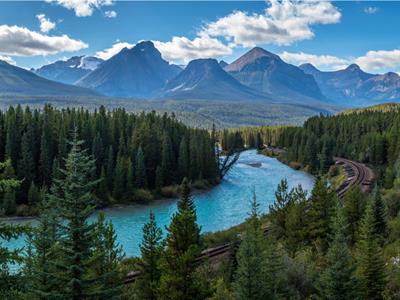
PUMPA - SMART LEARNING
எங்கள் ஆசிரியர்களுடன் 1-ஆன்-1 ஆலோசனை நேரத்தைப் பெறுங்கள். டாப்பர் ஆவதற்கு நாங்கள் பயிற்சி அளிப்போம்
Book Free DemoNorth America has an extensive river system flowing across the land and some following the glacier-formed valleys.
Being the longest rivers of North America, the Mississippi and Missouri rivers form the world's fourth longest river system stretching for about 6114 km from Montana to the Gulf of Mexico. Missouri river, after running for about 3700 km, is joined by Mississipi river.

Bow River with the beautiful Canadian Rockies in the background - Alberta, Canada
The second-largest drainage basin of North America is the Mackenzie River is , and also it is the longest river in Canada. It originates from Great Slave Lake in the Northwest Territories of Canada and drains into Arctic Ocean.
St. Lawrence, originating from Lake Ontario, flows northeast and drains into the Atlantic Ocean. River Columbia and its tributaries dissect the plateau of the west and formed many gorges and canyons.
Though they are a barrier for communication, they are dammed for irrigation and power. The River Yukon, which rises in the northwest of the Western mountain system, remains frozen for eight months in a year. The River Rio Grande, which forms the boundary between USA and Mexico, flows into Gulf of Mexico.
Rivers | Origin | Drainage |
| St. Lawrence | Lake Ontario | Atlantic Ocean |
| River Columbia | Columbia Lake in the Rocky Mountain | Pacific Ocean |
| Yukon | North-west of the Western mountain system | Bering Sea |
| Rio Grande | South-central Colorado | Gulf of Mexico |
| Mackenzie River | Great Slave Lake | Arctic Ocean |
| Ohio | confluence of the Allegheny and Monongahela rivers at Pittsburgh | Mississippi river |
| Colorado | La Poudre Pass Lake, Rocky mountains | Gulf of California |
As the river Mississippi erodes a lot of sand and mud when it rushes down, it is nicknamed as "The Big Muddy".